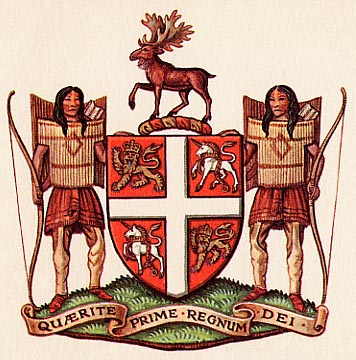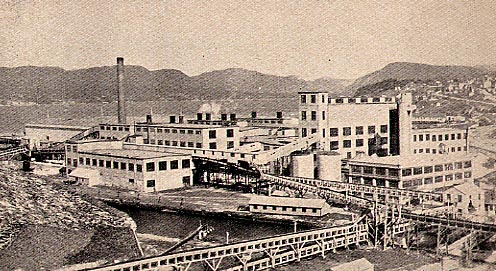
History

 |
Newfoundland History |
 |
Pulp and Paper Industry of Newfoundland
(to 1949)
[This text was written in 1949. For the full citation, see the end of the document. The links and image have been added to the original text by Claude Bélanger. The more recent developments may be explored at this site.]
The forests of Newfoundland now consist principally of pulpwood species: balsam fir, white and black spruce, and some second growth larch. Consequently the lumbering industry, which used white pine, has given way to a pulp-and-paper industry whose exports, in 1948, amounted to $ 40,000,000, or about half of all exports.
Production first began when the Newfoundland Wood Pulp Company, incorporated in 1897, built a sulphite mill with a daily capacity of 20 tons at Black River, Placentia bay. The mill, after operating for five or six years, was discontinued because of a shortage of water power, but had provided valuable information on possibilities of the industry on the island. Other ventures followed, and production is now [1949] in the hands of two large companies, the Anglo-Newfoundland Development Company and Bowater's Newfoundland Pulp and Paper Mills.
Bowater's holds limits amounting to 11,000 square miles, mostly along the north-west coast and in the Codroy, Humber, and Gander basins. The mill, erected at Corner Brook in 1923 by the Newfoundland Power and Paper Company and bought by Bowater's in 1936, has at present a daily capacity of 1,000 tons. The power house is at Deer lake. Shipping is done from Corner Brook and, in the winter, from Port aux Basques.
The Anglo-Newfoundland Development Company, incorporated in 1905, holds limits in the Exploits valley, the Terra Nova basin, and along the west shore of White bay, about 7,500 square miles in all. Power is generated at a dam across the Exploits river. A mill at Grand Falls, with daily capacity of 120 tons, was completed in 1909, and the present capacity is 600 tons. A groundwood mill, which was operated by A. E. Reed Ltd. at Bishop's Falls between 1909 and 1928, is now owned by Anglo-Newfoundland, and the ground-wood is pumped to the Grand Falls mill. The mills are connected by railway to the port of Botwood.

View of the Bowaters pulp and paper mill of Corner Brook
(early 1950's)
The two large companies provide seasonal employment in the woods for some 5,000 men, and steady employment for more than 3,000 in the mills.
Bibliography. See Forest resources and industries, a memorandum prepared for the British Empire Forestry Convention ( London, 1920); J. Turner, Forests of Newfoundland in J. R. Smallwood (ed.), Book of Newfoundland (St. John's, 1937); R. A. MacKay (ed.), Newfoundland: economic, diplomatic, and strategic studies (Toronto, 1946); G. Taylor, Newfoundland (Toronto, 1946).
Source: W. Stewart WALLACE, ed., The Encyclopedia of Canada. Newfoundland Supplement, Toronto, University Associates of Canada, 1949, 104p., p. 78.
© 2004 Claude Bélanger, Marianopolis College |